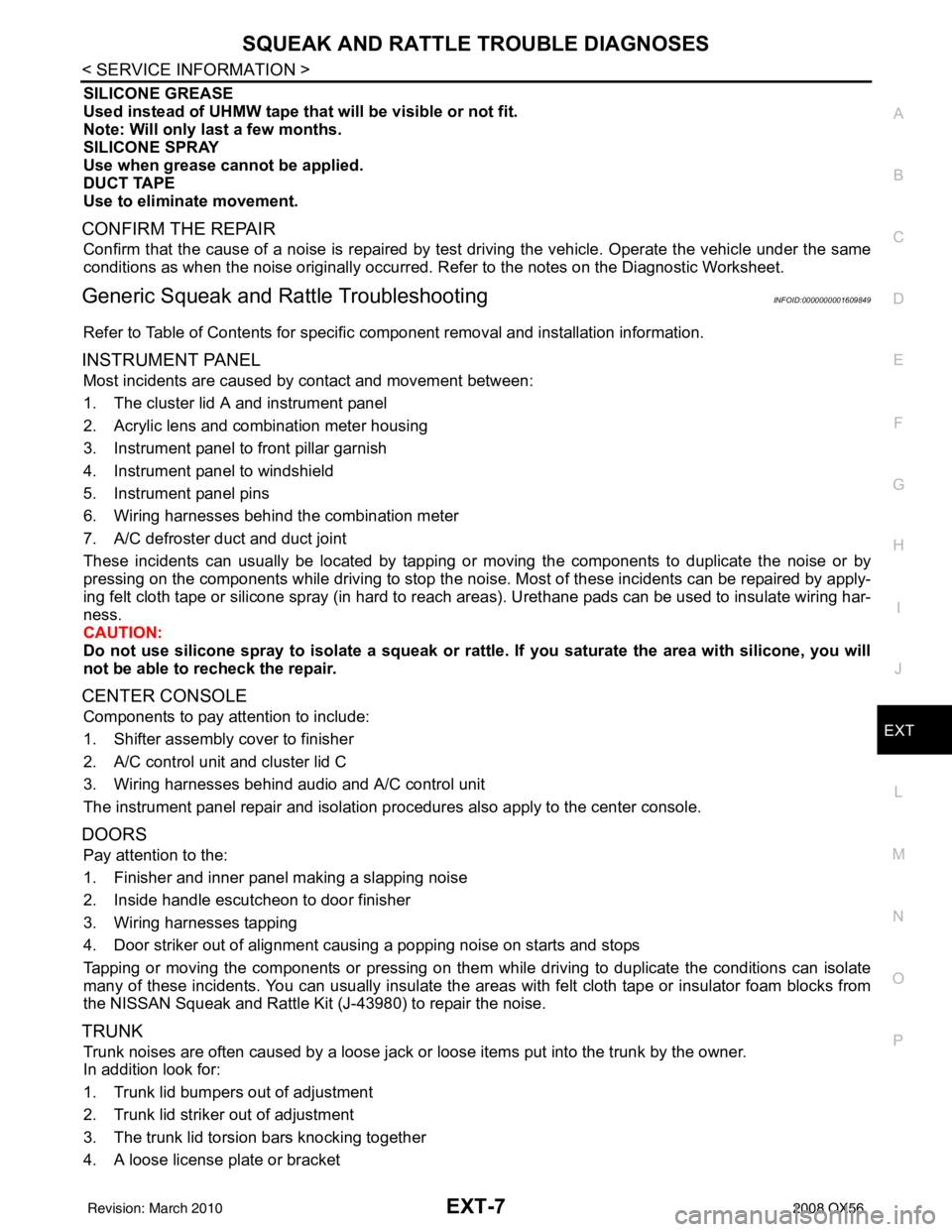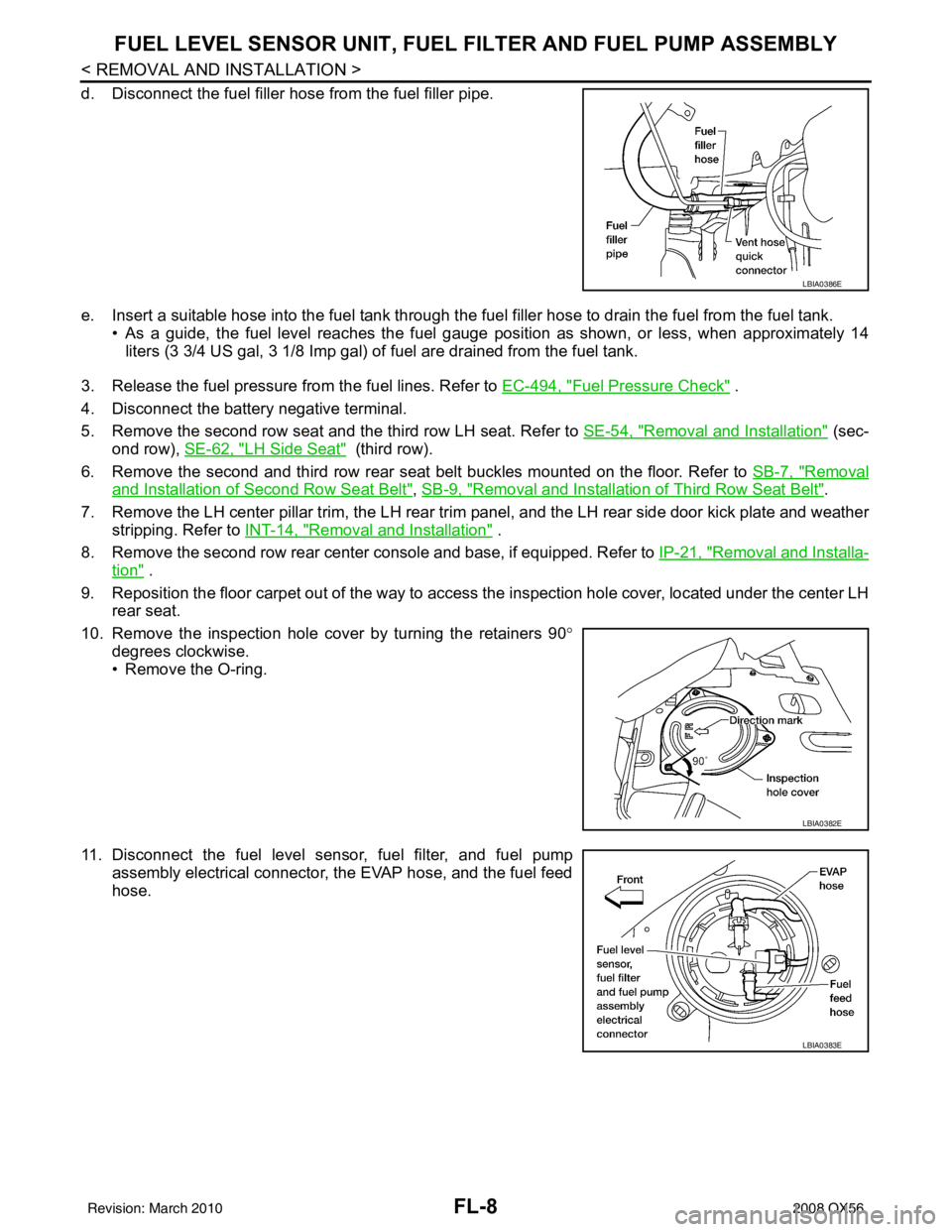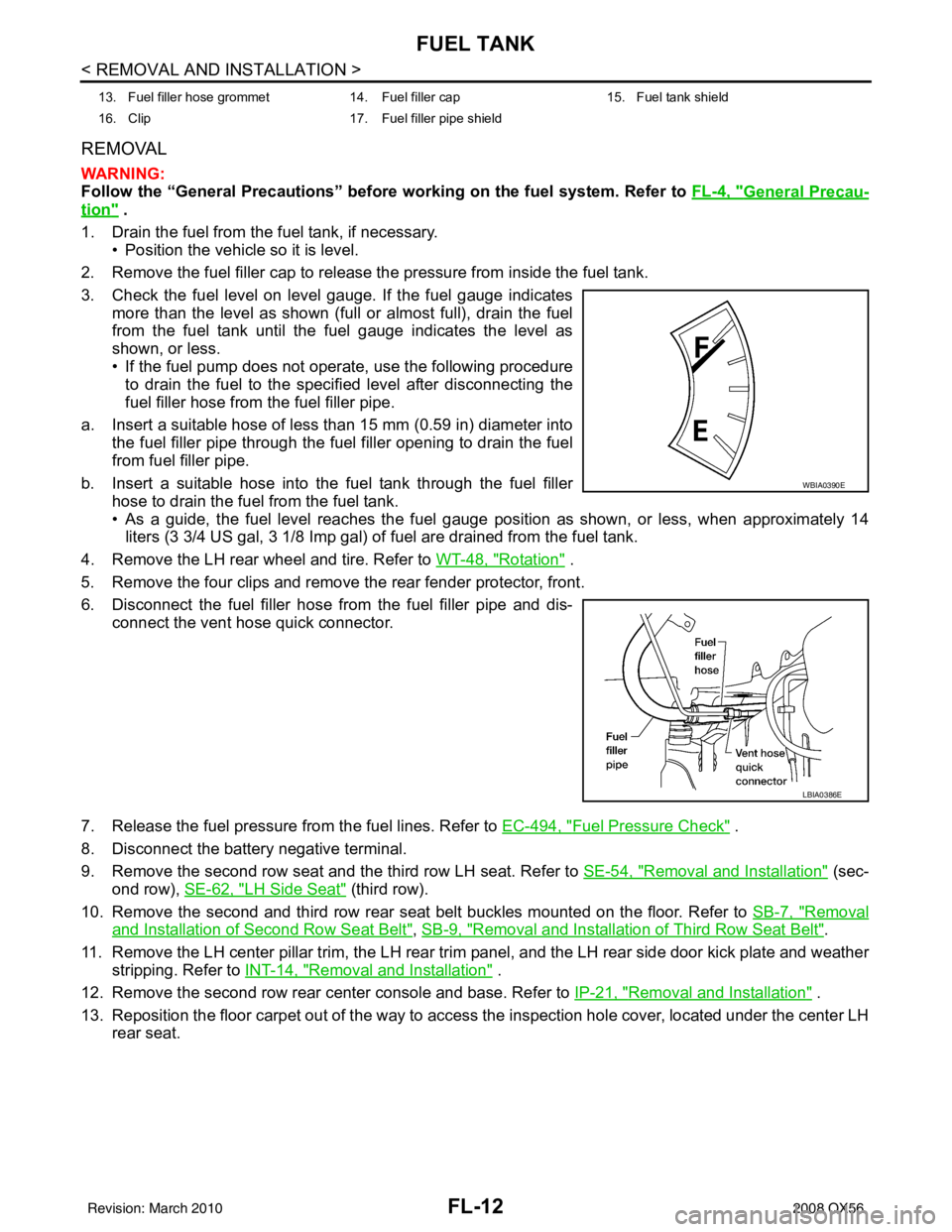2008 INFINITI QX56 center console
[x] Cancel search: center consolePage 996 of 4083
![INFINITI QX56 2008 Factory Service Manual DOOR LOCK FUNCTION SYMPTOMSDLK-203
< SYMPTOM DIAGNOSIS > [WITH INTELLIGENT KEY SYSTEM]
C
D
E
F
G H
I
J
L
M A
B
DLK
N
O P
Key reminder function does not operate properly. 1.
Check “ANTI KEY LOCK IN F INFINITI QX56 2008 Factory Service Manual DOOR LOCK FUNCTION SYMPTOMSDLK-203
< SYMPTOM DIAGNOSIS > [WITH INTELLIGENT KEY SYSTEM]
C
D
E
F
G H
I
J
L
M A
B
DLK
N
O P
Key reminder function does not operate properly. 1.
Check “ANTI KEY LOCK IN F](/manual-img/42/57030/w960_57030-995.png)
DOOR LOCK FUNCTION SYMPTOMSDLK-203
< SYMPTOM DIAGNOSIS > [WITH INTELLIGENT KEY SYSTEM]
C
D
E
F
G H
I
J
L
M A
B
DLK
N
O P
Key reminder function does not operate properly. 1.
Check “ANTI KEY LOCK IN FUNCTION” setting in “WORK
SUPPORT”.
DLK-48
2. Door switch check.
DLK-67
3a. Inside key antenna 1 (rear of center console) check.DLK-56
3b. Inside key antenna 2 (luggage compartment) check.DLK-58
3c. Inside key antenna 3 (front of center console) check.DLK-60
3d. Inside key antenna 4 (overhead console area) check.DLK-62
4. Front door lock actuator LH (door unlock sensor) check.DLK-77
5. Intelligent Key battery inspection.DLK-102
6. Replace Intelligent Key unit.SEC-116
Panic alarm function does not operate properly.1. Check “PANIC ALARM DELAY” setting in “WORK SUPPORT”.
DLK-49
2. Theft warning operation check.DLK-206
3. Intelligent Key battery inspection.DLK-102
4. Key switch check (BCM). D L K - 111
5. Ignition knob switch check.DLK-112
6. Replace Intelligent Key unit.SEC-116
Back door open function does not operate prop-
erly.1. Back door diagnosis.
DLK-1192. Intelligent Key battery inspection.DLK-102
3. Replace Intelligent Key unit.SEC-116
Power window down function does not operate.1. Check “PW DOWN SET” setti
ng in “WORK SUPPORT”. DLK-492. Intelligent Key battery inspection. DLK-102
SymptomDiagnosis/service procedureReference
page
Revision: March 2010 2008 QX56
Page 1000 of 4083
![INFINITI QX56 2008 Factory Service Manual WARNING FUNCTION SYMPTOMSDLK-207
< SYMPTOM DIAGNOSIS > [WITH INTELLIGENT KEY SYSTEM]
C
D
E
F
G H
I
J
L
M A
B
DLK
N
O P
Take away warning
does not operate. Door open to close
1. Check door switch.
DLK INFINITI QX56 2008 Factory Service Manual WARNING FUNCTION SYMPTOMSDLK-207
< SYMPTOM DIAGNOSIS > [WITH INTELLIGENT KEY SYSTEM]
C
D
E
F
G H
I
J
L
M A
B
DLK
N
O P
Take away warning
does not operate. Door open to close
1. Check door switch.
DLK](/manual-img/42/57030/w960_57030-999.png)
WARNING FUNCTION SYMPTOMSDLK-207
< SYMPTOM DIAGNOSIS > [WITH INTELLIGENT KEY SYSTEM]
C
D
E
F
G H
I
J
L
M A
B
DLK
N
O P
Take away warning
does not operate. Door open to close
1. Check door switch.
DLK-67
2. Check inside key antennas (1, 2, 3, 4).Rear of center console
DLK-56Luggage compartmentDLK-58
Front of center consoleDLK-60
Overhead console areaDLK-62
3. Check Intelligent Key warning buzzer. DLK-91
4. Check warning chime function.DLK-107
5. Check ignition knob switch. DLK-112
6. Check combination meter display function.DLK-106
7. Check Intermittent Incident. GI-38
Push-button igni-
tion switch opera-
tion1. Check ignition knob switch.
DLK-1122. Check inside key antennas (1, 2, 3, 4).Rear of center console
DLK-56Luggage compartmentDLK-58
Front of center consoleDLK-60
Overhead console areaDLK-62
3. Check warning chime function. DLK-107
4. Check combination meter display function.DLK-106
5. Check Intermittent Incident. GI-38
Door is open1. Check ignition knob switch.
DLK-1122. Check inside key antennas (1, 2, 3, 4).Rear of center console
DLK-56Luggage compartmentDLK-58
Front of center consoleDLK-60
Overhead console areaDLK-62
3. Check combination meter display function. DLK-106
4. Check Intermittent Incident. GI-38
Take away through
window1.
Check “TAKE OUT FROM WIN WARN” setting in “WORK SUP-
PORT”.
DLK-51
2. Check inside key antennas (1, 2, 3, 4).Rear of center console
DLK-56Luggage compartmentDLK-58
Front of center consoleDLK-60
Overhead console areaDLK-62
3. Check warning chime function. DLK-107
4. Check ignition knob switch. DLK-112
5. Check combination meter display function.DLK-106
6. Check Intermittent Incident. GI-38
Key warning chime does not operate.1. Check door switch.
DLK-67
2. Check warning chime function.DLK-107
3. Check ignition knob switch. DLK-112
4. Check combination meter display function.DLK-106
5. Check Intermittent Incident. GI-38
SymptomDiagnosis/service procedure Reference
page
Revision: March 2010 2008 QX56
Page 1001 of 4083
![INFINITI QX56 2008 Factory Service Manual DLK-208
< SYMPTOM DIAGNOSIS >[WITH INTELLIGENT KEY SYSTEM]
WARNING FUNCTION SYMPTOMS
Door lock operation warning chime does
not operate.1. Check door switch.
DLK-67
2. Check ignition knob switch.DLK- INFINITI QX56 2008 Factory Service Manual DLK-208
< SYMPTOM DIAGNOSIS >[WITH INTELLIGENT KEY SYSTEM]
WARNING FUNCTION SYMPTOMS
Door lock operation warning chime does
not operate.1. Check door switch.
DLK-67
2. Check ignition knob switch.DLK-](/manual-img/42/57030/w960_57030-1000.png)
DLK-208
< SYMPTOM DIAGNOSIS >[WITH INTELLIGENT KEY SYSTEM]
WARNING FUNCTION SYMPTOMS
Door lock operation warning chime does
not operate.1. Check door switch.
DLK-67
2. Check ignition knob switch.DLK-112
3. Check Intelligent Key warning buzzer. DLK-91
4. Check inside key antennas (1, 2, 3, 4).Rear of center console
DLK-56Luggage compartmentDLK-58
Front of center consoleDLK-60
Overhead console areaDLK-62
5. Check Intermittent Incident. GI-38
SymptomDiagnosis/service procedure Reference
page
Revision: March 2010 2008 QX56
Page 1002 of 4083
![INFINITI QX56 2008 Factory Service Manual KEY REMINDER FUNCTION SYMPTOMSDLK-209
< SYMPTOM DIAGNOSIS > [WITH INTELLIGENT KEY SYSTEM]
C
D
E
F
G H
I
J
L
M A
B
DLK
N
O P
KEY REMINDER FUNCTION SYMPTOMS
Symptom TableINFOID:0000000001539072
KEY REMI INFINITI QX56 2008 Factory Service Manual KEY REMINDER FUNCTION SYMPTOMSDLK-209
< SYMPTOM DIAGNOSIS > [WITH INTELLIGENT KEY SYSTEM]
C
D
E
F
G H
I
J
L
M A
B
DLK
N
O P
KEY REMINDER FUNCTION SYMPTOMS
Symptom TableINFOID:0000000001539072
KEY REMI](/manual-img/42/57030/w960_57030-1001.png)
KEY REMINDER FUNCTION SYMPTOMSDLK-209
< SYMPTOM DIAGNOSIS > [WITH INTELLIGENT KEY SYSTEM]
C
D
E
F
G H
I
J
L
M A
B
DLK
N
O P
KEY REMINDER FUNCTION SYMPTOMS
Symptom TableINFOID:0000000001539072
KEY REMINDER FUNCTION MALFUNCTION
NOTE:
• Before performing the diagnosis in the following table, check “Work flow”. Refer to DLK-6, "
Work Flow".
• If the following symptoms” are detected, check systems shown in the “Diagnosis/service procedure” column in this order.
Conditions of Vehicle (Operating Conditions)
• “LOCK/UNLOCK BY I-KEY” is ON when setting on CONSULT-III.
• “ANSWER BACK FUNCTION” is ON when setting on CONSULT-III.
• Ignition switch is in OFF position.
• All doors are closed.
• Ignition switch is not depressed.
Symptom Diagnosis/service procedureReference page
Key reminder function does not operate. 1.
Check “ANTI KEY LOCK IN FUNCTI”setting in “WORK SUP-
PORT”. DLK-51
2. Check door switch.
DLK-67
3. Check inside key antennas (1, 2, 3, 4)Rear of center console
DLK-56Luggage compartmentDLK-58
Front of center consoleDLK-60
Overhead console areaDLK-62
4. Check unlock sensor. DLK-77
5. Check Intelligent Key battery inspection.DLK-102
6. Check Intermittent Incident. GI-38
Revision: March 2010 2008 QX56
Page 1008 of 4083
![INFINITI QX56 2008 Factory Service Manual SQUEAK AND RATTLE TROUBLE DIAGNOSESDLK-215
< SYMPTOM DIAGNOSIS > [WITH INTELLIGENT KEY SYSTEM]
C
D
E
F
G H
I
J
L
M A
B
DLK
N
O P
Insulates where slight movement is present. Ideal for instrument panel INFINITI QX56 2008 Factory Service Manual SQUEAK AND RATTLE TROUBLE DIAGNOSESDLK-215
< SYMPTOM DIAGNOSIS > [WITH INTELLIGENT KEY SYSTEM]
C
D
E
F
G H
I
J
L
M A
B
DLK
N
O P
Insulates where slight movement is present. Ideal for instrument panel](/manual-img/42/57030/w960_57030-1007.png)
SQUEAK AND RATTLE TROUBLE DIAGNOSESDLK-215
< SYMPTOM DIAGNOSIS > [WITH INTELLIGENT KEY SYSTEM]
C
D
E
F
G H
I
J
L
M A
B
DLK
N
O P
Insulates where slight movement is present. Ideal for instrument panel applications.
SILICONE GREASE
Used in place of UHMW tape that will be visible or not fit. Will only last a few months.
SILICONE SPRAY
Use when grease cannot be applied.
DUCT TAPE
Use to eliminate movement.
CONFIRM THE REPAIR
Confirm that the cause of a noise is repaired by test driving the vehicle. Operate the vehicle under the same
conditions as when the noise originally occurred. Refer to the notes on the Diagnostic Worksheet.
Inspection ProcedureINFOID:0000000001539077
Refer to Table of Contents for specific component removal and installation information.
INSTRUMENT PANEL
Most incidents are caused by contact and movement between:
1. The cluster lid A and instrument panel
2. Acrylic lens and combination meter housing
3. Instrument panel to front pillar garnish
4. Instrument panel to windshield
5. Instrument panel mounting pins
6. Wiring harnesses behind the combination meter
7. A/C defroster duct and duct joint
These incidents can usually be located by tapping or moving the components to duplicate the noise or by
pressing on the components while driving to stop the noi se. Most of these incidents can be repaired by apply-
ing felt cloth tape or silicon spray (in hard to reach areas). Urethane pads can be used to insulate wiring har-
ness.
CAUTION:
Do not use silicone spray to isolate a squeak or ra ttle. If you saturate the area with silicone, you will
not be able to recheck the repair.
CENTER CONSOLE
Components to pay attention to include:
1. Shifter assembly cover to finisher
2. A/C control unit and cluster lid C
3. Wiring harnesses behind audio and A/C control unit
The instrument panel repair and isolation pr ocedures also apply to the center console.
DOORS
Pay attention to the:
1. Finisher and inner panel making a slapping noise
2. Inside handle escutcheon to door finisher
3. Wiring harnesses tapping
4. Door striker out of alignment causing a popping noise on starts and stops
Tapping or moving the components or pressing on them while driving to duplicate the conditions can isolate
many of these incidents. You can usually insulate the ar eas with felt cloth tape or insulator foam blocks from
the Nissan Squeak and Rattle Kit (J-43980) to repair the noise.
TRUNK
Trunk noises are often caused by a loose jack or loose items put into the trunk by the owner.
In addition look for:
1. Trunk lid bumpers out of adjustment
2. Trunk lid striker out of adjustment
3. The trunk lid torsion bars knocking together
4. A loose license plate or bracket
Revision: March 2010 2008 QX56
Page 2060 of 4083

SQUEAK AND RATTLE TROUBLE DIAGNOSESEXT-7
< SERVICE INFORMATION >
C
DE
F
G H
I
J
L
M A
B
EXT
N
O P
SILICONE GREASE
Used instead of UHMW tape that will be visible or not fit.
Note: Will only last a few months.
SILICONE SPRAY
Use when grease cannot be applied.
DUCT TAPE
Use to eliminate movement.
CONFIRM THE REPAIR
Confirm that the cause of a noise is repaired by test driving the vehicle. Operate the vehicle under the same
conditions as when the noise originally occurred. Refer to the notes on the Diagnostic Worksheet.
Generic Squeak and Rattle TroubleshootingINFOID:0000000001609849
Refer to Table of Contents for specific component removal and installation information.
INSTRUMENT PANEL
Most incidents are caused by contact and movement between:
1. The cluster lid A and instrument panel
2. Acrylic lens and combination meter housing
3. Instrument panel to front pillar garnish
4. Instrument panel to windshield
5. Instrument panel pins
6. Wiring harnesses behind the combination meter
7. A/C defroster duct and duct joint
These incidents can usually be located by tapping or moving the components to duplicate the noise or by
pressing on the components while driving to stop the noi se. Most of these incidents can be repaired by apply-
ing felt cloth tape or silicone spray (in hard to reach areas). Urethane pads can be used to insulate wiring har-
ness.
CAUTION:
Do not use silicone spray to isolate a squeak or ra ttle. If you saturate the area with silicone, you will
not be able to recheck the repair.
CENTER CONSOLE
Components to pay attention to include:
1. Shifter assembly cover to finisher
2. A/C control unit and cluster lid C
3. Wiring harnesses behind audio and A/C control unit
The instrument panel repair and isolation pr ocedures also apply to the center console.
DOORS
Pay attention to the:
1. Finisher and inner panel making a slapping noise
2. Inside handle escutcheon to door finisher
3. Wiring harnesses tapping
4. Door striker out of alignment causing a popping noise on starts and stops
Tapping or moving the components or pressing on them while driving to duplicate the conditions can isolate
many of these incidents. You can usually insulate the ar eas with felt cloth tape or insulator foam blocks from
the NISSAN Squeak and Rattle Kit (J-43980) to repair the noise.
TRUNK
Trunk noises are often caused by a loose jack or loose items put into the trunk by the owner.
In addition look for:
1. Trunk lid bumpers out of adjustment
2. Trunk lid striker out of adjustment
3. The trunk lid torsion bars knocking together
4. A loose license plate or bracket
Revision: March 2010 2008 QX56
Page 2108 of 4083

FL-8
< REMOVAL AND INSTALLATION >
FUEL LEVEL SENSOR UNIT, FUEL FILTER AND FUEL PUMP ASSEMBLY
d. Disconnect the fuel filler hose from the fuel filler pipe.
e. Insert a suitable hose into the fuel tank through the fuel filler hose to drain the fuel from the fuel tank.
• As a guide, the fuel level reaches the fuel gauge position as shown, or less, when approximately 14
liters (3 3/4 US gal, 3 1/8 Imp gal) of fuel are drained from the fuel tank.
3. Release the fuel pressure from the fuel lines. Refer to EC-494, "
Fuel Pressure Check" .
4. Disconnect the battery negative terminal.
5. Remove the second row seat and the third row LH seat. Refer to SE-54, "
Removal and Installation" (sec-
ond row), SE-62, "
LH Side Seat" (third row).
6. Remove the second and third row rear seat belt buckles mounted on the floor. Refer to SB-7, "
Removal
and Installation of Second Row Seat Belt", SB-9, "Removal and Installation of Third Row Seat Belt".
7. Remove the LH center pillar trim, the LH rear trim panel, and the LH rear side door kick plate and weather
stripping. Refer to INT-14, "
Removal and Installation" .
8. Remove the second row rear center console and base, if equipped. Refer to IP-21, "
Removal and Installa-
tion" .
9. Reposition the floor carpet out of the way to access the inspection hole cover, located under the center LH
rear seat.
10. Remove the inspection hole cover by turning the retainers 90 °
degrees clockwise.
• Remove the O-ring.
11. Disconnect the fuel level sensor, fuel filter, and fuel pump assembly electrical connector, the EVAP hose, and the fuel feed
hose.
LBIA0386E
LBIA0382E
LBIA0383E
Revision: March 2010 2008 QX56
Page 2112 of 4083

FL-12
< REMOVAL AND INSTALLATION >
FUEL TANK
REMOVAL
WARNING:
Follow the “General Precautions” before working on the fuel system. Refer to FL-4, "
General Precau-
tion" .
1. Drain the fuel from the fuel tank, if necessary. • Position the vehicle so it is level.
2. Remove the fuel filler cap to release the pressure from inside the fuel tank.
3. Check the fuel level on level gauge. If the fuel gauge indicates more than the level as shown (full or almost full), drain the fuel
from the fuel tank until the fuel gauge indicates the level as
shown, or less.
• If the fuel pump does not operate, use the following procedure
to drain the fuel to the specified level after disconnecting the
fuel filler hose from the fuel filler pipe.
a. Insert a suitable hose of less than 15 mm (0.59 in) diameter into the fuel filler pipe through the fuel filler opening to drain the fuel
from fuel filler pipe.
b. Insert a suitable hose into the fuel tank through the fuel filler hose to drain the fuel from the fuel tank.
• As a guide, the fuel level reaches the fuel gauge position as shown, or less, when approximately 14
liters (3 3/4 US gal, 3 1/8 Imp gal) of fuel are drained from the fuel tank.
4. Remove the LH rear wheel and tire. Refer to WT-48, "
Rotation" .
5. Remove the four clips and remove the rear fender protector, front.
6. Disconnect the fuel filler hose from the fuel filler pipe and dis- connect the vent hose quick connector.
7. Release the fuel pressure from the fuel lines. Refer to EC-494, "
Fuel Pressure Check" .
8. Disconnect the battery negative terminal.
9. Remove the second row seat and the third row LH seat. Refer to SE-54, "
Removal and Installation" (sec-
ond row), SE-62, "
LH Side Seat" (third row).
10. Remove the second and third row rear seat belt buckles mounted on the floor. Refer to SB-7, "
Removal
and Installation of Second Row Seat Belt", SB-9, "Removal and Installation of Third Row Seat Belt".
11. Remove the LH center pillar trim, the LH rear trim panel, and the LH rear side door kick plate and weather
stripping. Refer to INT-14, "
Removal and Installation" .
12. Remove the second row rear center console and base. Refer to IP-21, "
Removal and Installation" .
13. Reposition the floor carpet out of the way to access the inspection hole cover, located under the center LH
rear seat.
13. Fuel filler hose grommet 14. Fuel filler cap 15. Fuel tank shield
16. Clip 17. Fuel filler pipe shield
WBIA0390E
LBIA0386E
Revision: March 2010 2008 QX56